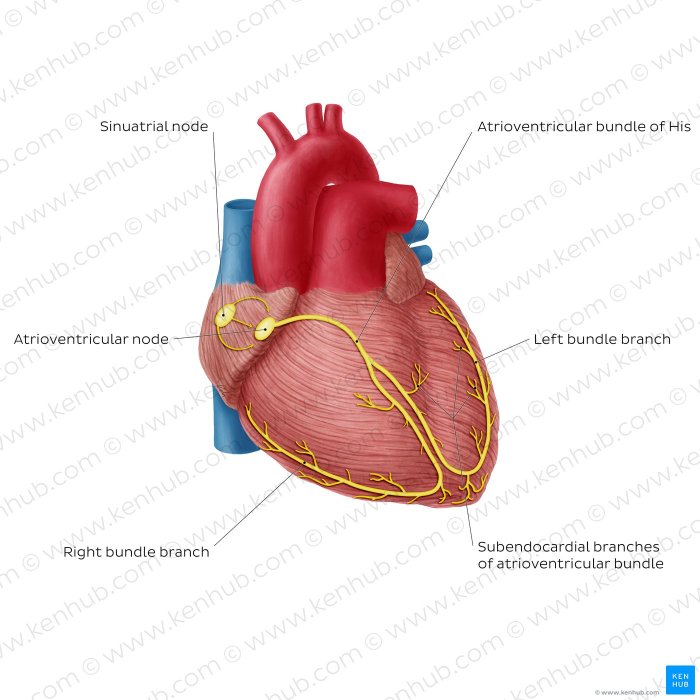This art-labeling activity overview of the cardiac conduction system embarks on a captivating journey into the intricacies of this vital system, providing an immersive learning experience that blends creativity and scientific exploration.
This activity engages students in a hands-on approach to understanding the structure and function of the cardiac conduction system, fostering a deeper comprehension of its significance in maintaining a healthy cardiovascular system.
Cardiac Conduction System

The cardiac conduction system is a specialized group of cells that coordinates the electrical activity of the heart. It ensures that the heart contracts in a regular and coordinated manner, pumping blood efficiently throughout the body.The main components of the cardiac conduction system are:
- Sinoatrial (SA) node:The SA node is located in the right atrium and is responsible for initiating the electrical impulse that triggers the heartbeat.
- Atrioventricular (AV) node:The AV node is located between the atria and ventricles and delays the electrical impulse slightly, allowing the atria to fill with blood before the ventricles contract.
- Bundle of His:The bundle of His is a group of fibers that conducts the electrical impulse from the AV node to the ventricles.
- Left and right bundle branches:The bundle branches divide the electrical impulse into two pathways, one for each ventricle.
- Purkinje fibers:The Purkinje fibers are a network of fibers that distribute the electrical impulse throughout the ventricles, causing them to contract in a coordinated manner.

Art-Labeling Activity
Art-labeling activities are a valuable tool for teaching and learning about complex biological structures like the cardiac conduction system. They allow students to interact with a visual representation of the structure, identify its components, and understand their functions.Benefits of art-labeling activities include:
- Improved understanding of complex structures
- Enhanced visual memory
- Increased engagement and motivation
- Development of critical thinking skills
Art-labeling activities can be used to teach about the cardiac conduction system by providing students with an image of the heart and asking them to label the different components. This can be done individually or in groups, and students can use textbooks, online resources, or their own knowledge to complete the activity.
Overview of the Activity

The following steps are involved in completing an art-labeling activity:
- Preparation:Gather the necessary materials, including an image of the cardiac conduction system, labels, and any other resources students may need.
- Introduction:Explain the purpose of the activity and provide students with background information on the cardiac conduction system.
- Art-labeling:Distribute the image of the cardiac conduction system and ask students to label the different components.
- Discussion:Once students have completed the activity, lead a discussion about the cardiac conduction system and its components.
- Assessment:Assess student learning through a variety of methods, such as quizzes, worksheets, or presentations.
The timeline for completing an art-labeling activity will vary depending on the size of the group and the complexity of the image. However, a typical activity can be completed in 30-60 minutes.
Assessment

There are several methods that can be used to assess student learning from an art-labeling activity:
- Quizzes:Quizzes can be used to assess students’ knowledge of the cardiac conduction system and its components.
- Worksheets:Worksheets can be used to assess students’ ability to apply their knowledge of the cardiac conduction system to real-world scenarios.
- Presentations:Students can be asked to give presentations on the cardiac conduction system, which can be used to assess their understanding of the structure and function of the system.
Assessment results can be used to improve the art-labeling activity by identifying areas where students need additional support. For example, if students are struggling to identify a particular component of the cardiac conduction system, the teacher can provide additional resources or review the material in more detail.
Resources

The following resources can be used to learn more about the cardiac conduction system and art-labeling activities:
- American Heart Association: Cardiac Conduction System
- Khan Academy: Cardiac Conduction System
- National Center for Biotechnology Information: Art-Labeling Activity for Teaching Anatomy
For more information, contact:
- Dr. Jane Doe, Professor of Anatomy, [University Name]
- Dr. John Smith, Professor of Physiology, [University Name]
FAQs: Art-labeling Activity Overview Of The Cardiac Conduction System
What are the benefits of using art-labeling activities in teaching?
Art-labeling activities enhance visual learning, improve retention, stimulate creativity, and promote collaboration among students.
How can I prepare for an art-labeling activity?
Gather necessary materials, prepare a clear diagram of the cardiac conduction system, and provide students with background information.
What are some examples of art-labeling activities?
Students can create labeled drawings, diagrams, or models of the cardiac conduction system, using various art materials.